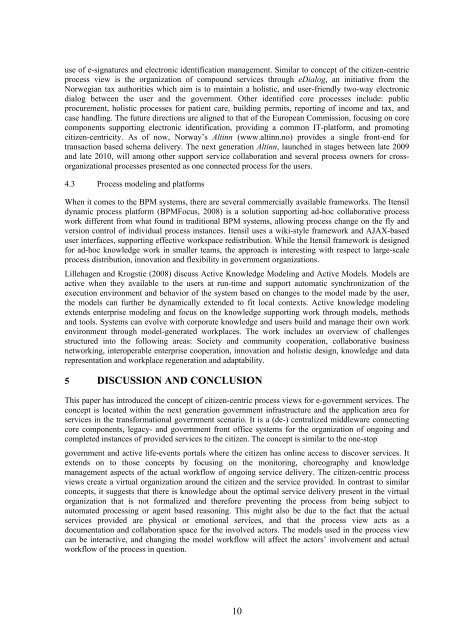Multi-channel provisioning of public services - Department of ...
Multi-channel provisioning of public services - Department of ...
Multi-channel provisioning of public services - Department of ...
You also want an ePaper? Increase the reach of your titles
YUMPU automatically turns print PDFs into web optimized ePapers that Google loves.
use <strong>of</strong> e-signatures and electronic identification management. Similar to concept <strong>of</strong> the citizen-centric<br />
process view is the organization <strong>of</strong> compound <strong>services</strong> through eDialog, an initiative from the<br />
Norwegian tax authorities which aim is to maintain a holistic, and user-friendly two-way electronic<br />
dialog between the user and the government. Other identified core processes include: <strong>public</strong><br />
procurement, holistic processes for patient care, building permits, reporting <strong>of</strong> income and tax, and<br />
case handling. The future directions are aligned to that <strong>of</strong> the European Commission, focusing on core<br />
components supporting electronic identification, providing a common IT-platform, and promoting<br />
citizen-centricity. As <strong>of</strong> now, Norway’s Altinn (www.altinn.no) provides a single front-end for<br />
transaction based schema delivery. The next generation Altinn, launched in stages between late 2009<br />
and late 2010, will among other support service collaboration and several process owners for crossorganizational<br />
processes presented as one connected process for the users.<br />
4.3 Process modeling and platforms<br />
When it comes to the BPM systems, there are several commercially available frameworks. The Itensil<br />
dynamic process platform (BPMFocus, 2008) is a solution supporting ad-hoc collaborative process<br />
work different from what found in traditional BPM systems, allowing process change on the fly and<br />
version control <strong>of</strong> individual process instances. Itensil uses a wiki-style framework and AJAX-based<br />
user interfaces, supporting effective workspace redistribution. While the Itensil framework is designed<br />
for ad-hoc knowledge work in smaller teams, the approach is interesting with respect to large-scale<br />
process distribution, innovation and flexibility in government organizations.<br />
Lillehagen and Krogstie (2008) discuss Active Knowledge Modeling and Active Models. Models are<br />
active when they available to the users at run-time and support automatic synchronization <strong>of</strong> the<br />
execution environment and behavior <strong>of</strong> the system based on changes to the model made by the user,<br />
the models can further be dynamically extended to fit local contexts. Active knowledge modeling<br />
extends enterprise modeling and focus on the knowledge supporting work through models, methods<br />
and tools. Systems can evolve with corporate knowledge and users build and manage their own work<br />
environment through model-generated workplaces. The work includes an overview <strong>of</strong> challenges<br />
structured into the following areas: Society and community cooperation, collaborative business<br />
networking, interoperable enterprise cooperation, innovation and holistic design, knowledge and data<br />
representation and workplace regeneration and adaptability.<br />
5 DISCUSSION AND CONCLUSION<br />
This paper has introduced the concept <strong>of</strong> citizen-centric process views for e-government <strong>services</strong>. The<br />
concept is located within the next generation government infrastructure and the application area for<br />
<strong>services</strong> in the transformational government scenario. It is a (de-) centralized middleware connecting<br />
core components, legacy- and government front <strong>of</strong>fice systems for the organization <strong>of</strong> ongoing and<br />
completed instances <strong>of</strong> provided <strong>services</strong> to the citizen. The concept is similar to the one-stop<br />
government and active life-events portals where the citizen has online access to discover <strong>services</strong>. It<br />
extends on to those concepts by focusing on the monitoring, choreography and knowledge<br />
management aspects <strong>of</strong> the actual workflow <strong>of</strong> ongoing service delivery. The citizen-centric process<br />
views create a virtual organization around the citizen and the service provided. In contrast to similar<br />
concepts, it suggests that there is knowledge about the optimal service delivery present in the virtual<br />
organization that is not formalized and therefore preventing the process from being subject to<br />
automated processing or agent based reasoning. This might also be due to the fact that the actual<br />
<strong>services</strong> provided are physical or emotional <strong>services</strong>, and that the process view acts as a<br />
documentation and collaboration space for the involved actors. The models used in the process view<br />
can be interactive, and changing the model workflow will affect the actors’ involvement and actual<br />
workflow <strong>of</strong> the process in question.<br />
10
















